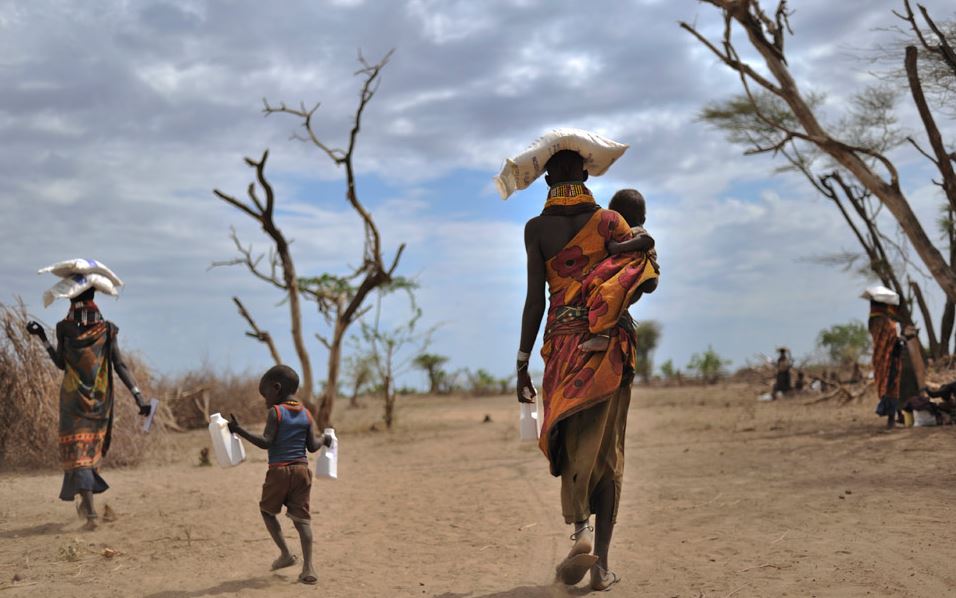
Image credit: http://oilinkenya.co.ke/kenya-africas-hottest-emerging-oil-exporter/ (Sept. 27th 2014)
An estimated 600 million barrels of oil have recently been discovered in Kenya by Tullow Oil and the Africa Oil Corp.
Tullow Oil is a multinational oil and gas exploration company founded in Tullow, Ireland with its headquarters in London, United Kingdom.
Africa Oil Corp is a Canadian oil and gas company with assets in Kenya and Ethiopia as well as Puntland (Somalia) through its 45% equity interest in Horn Petroleum Corporation.
Africa Oil Corp’s East African holdings are in within a world-class exploration play fairway with a total gross land package in this prolific region in excess of 215,000 square kilometers.
The East African Rift Basin system is one of the last of the great rift basins to be explored.
Several new significant oil discoveries have been announced in the Lokichar basin of Kenya in which the Company holds a 50% interest along with operator Tullow Oil plc.
Tullow Oil and the Africa Oil Corp made their first crude oil find in Kenya in March, 2012.
The Kenyan government is pushing ahead, quickly, with plans to start construction on an oil pipeline that will interface with Uganda and the coastal town of Lamu in Coast Province, Kenya.
Kenya has licensed 41 out of its 46 oil and gas blocks to 21 companies including BG Group Plc, Eni SpA , Anadarko Petroleum Corp and Total SA.
Most licenses will move to the drilling stage next year because that is when their initial license period of two to three years starts to expire.
On August 2nd 2014 Kenyan President Uhuru Kenyatta said that Kenya may start producing oil at the end of the decade, as it aims for quicker production of natural gas to first meet domestic power-generation needs before any surplus supplies can be exported.
Kenya President Kenyatta said that his administration plans to have new legislation in the coming months to guide activities of the oil and natural gas industries and maximize the country’s benefits from these sectors.
Recommended reading:
Prague Post (Sept. 28, 2014):
All Eyes on Kenya: The Next Big Oil Exporter
Bloomberg (Sept. 18, 2014):
Kenya Sees Oil Resources Almost Doubling With More Drilling
Malta Today (Sept. 25, 2014):
All eyes on Kenya, the next big oil exporter
Huffington Post (Sept. 24, 2014):
Kenya: Africa’s Hottest Emerging Oil Exporter
The Christian Science Monitor (September 22, 2014):
People’s Climate March; Scottish oil and gas; Kenya’s energy boom [Recharge]
Please exercise your free speech in the comments section below. There are no stipulations of political correctness on this blog. Speak your mind, give us your thoughts, both objective and subjective. Share your ideas, hunches, inklings or your expertise. Please provide recommendation and corrections if you spot errors in fact within the blog report. Lastly, remember that posting a comment is much like casting a vote, so please do so.









Judging by the tags, its kind of difficult what you’re trying to say here.
See the same old jerk off obots with their different sock puppets are still posting the same ridiculous crazy BS here. Go back to Davidson’s where you are with friends and sympathizers.
Someone’s just bitter that birtherism is proving to be the single least convincing conspiracy theory since “hollow earth”.
SIZE PERSPECTIVE (?) – KENYA’S RECENTLY DISCOVERED OIL FIELD
According to the information given in the below-excerpted article, Kenya’s recently discovered oil field would be size-classified in the category: GIANT
—————————————————–
The Ten Largest Oil Deposits in the World
24/7 Wall Street
8/31/2011
Excerpt:
Figuring out how much oil is left in the world and where it is located seems more important than ever, especially considering the political instability in many of the oil-producing countries. 24/7 Wall St. used the most recent public information available to identify the largest oil fields in the world. Those who call for America to end its dependence on foreign oil would be relived to hear the U.S. actually has the world’s largest oil reserve, albeit in oil shale — oil that is in rock form. If prices go high enough, however, and the supply dries out, extracting that oil could become commercially viable.
There are more than 40,000 producing oil fields dotted around the globe, though most are relatively small. Just 100 to 125 giant or supergiant oil fields supply approximately 50% of the world’s oil. A giant oil field is one that contains more than 500 million barrels of recoverable oil. A supergiant fields holds more than 5 billion barrels of recoverable oil. 24/7 Wall St.’s ten largest oil fields in the world are all supergiants. -(bold emphasis added)
Interestingly, the largest deposits ever found are not liquid oil at all. They are either an asphalt-like substance called tar or oil sands, or rocks called oil shale. The vast size of these “unconventional” resources is matched only by the vast complexity and cost involved in turning them into liquid petroleum.
Finding new giant and supergiant oil fields brimming with cheap, easy-to-extract oil is surely a historical phenomenon, and the number of new discoveries — of any size — is dwindling. In addition, the largest recent finds are under miles of water and seabed, in some unconventional form or in some inhospitable, usually arctic, climate. The effort required to tap these fields will involve mountains of capital and years of work. No doubt, we need to be prepared to deal with a new reality where oil isn’t as cheap or abundant.
24/7 Wall St. looked at conventional oil fields, like those found in the Middle East, and unconventional oil fields, like oil shale found in the U.S., to come up with a comprehensive list of the largest oil deposits in the world.
These are 24/7 Wall St.’s ten largest oil deposit in the world.
10. Ferdows
> Country: Iran
> Est. Total Resource: 31 billion barrels
> Est. Remaining: 31 billion barrels
> Discovery Date: 2003
Iran’s Ferdows field is located about 50 miles offshore of the country’s Bushehr province. Together with two other fields in the group, Mound and Zagheh, the three are believed to hold 38.5 billion barrels of oil. Ferdows also contains trillions of cubic feet of natural gas, and Iran has signed an agreement with a Malaysian company to develop a natural gas liquefaction plant that could be in operation by 2014. U.S.-led sanctions against Iran have made it difficult for the country to develop its substantial oil reserves and its even more substantial natural gas reserves.
9………………………………………..
View the complete article at:
http://247wallst.com/energy-business/2011/08/31/the-ten-largest-oil-deposits-in-the-world/
@ Langolier:brilliant post there jerk off!
@ Fan of Falcon:
Don’t forget accurate, and before you try and dispute that, keep in mind that everything birthers have done, has all been a flash in the pan. Any time someone who is in a position to “do something about it”, has asked for verification from Hawaii, they got it, and they were satisfied with it.
Now, I’m not naive enough to think for one moment, that birthers are going to give it up any time soon. Hell it’s been forty-five years and there are still kooks that maintain that the moon landings were faked, and you know what we do to this people? We laugh at them. That is birtherism’s legacy, to be a historical footnote to be giggled at.
@ Langolier:Really, the opinion of a sock puppet. Hmmmmmm, cute but extremely stupid. Go back, go back, go back to your hood. Your team gots no class and your coach bees no good. Jerk offs all of ya!
@ Fan of Falcon:
So aside from Ad hominems, what else you got?
Yeah, nothing. That’s what I thought.
You really think I’m going to leave, just because you tell me to?
You have no pull here.
@ Langolier:What? There must be some sense in your post of nonsense that only jerk off obots or their sock puppets can see. Freakin obots.
Excerpt from the Tullow Oil 2013 Annual Report — ‘Special Feature Kenya’
——————————————————-
“THIS IS A VERY EXCITING TIME FOR KENYA & ITS NATURAL RESOURCES HOLD SIGNIFICANT POTENTIAL FOR THE COUNTRY.”
The discoveries made by Tullow over the last two years have put Kenya at the heart of East Africa’s emerging oil province. Despite this success, we do not underestimate the challenges that lie ahead in bringing first oil to market.
Development and production of these resources is a long-term proposition, and so we must work together with stakeholders to build understanding and knowledge about what activities need to take place at each stage of the journey.
Securing an appropriate and economically viable plan for development will be critical to project success, however having the right infrastructure in place to support oil production will be equally important. Significant infrastructure upgrades will be required in order to transport the oil from an area largely inaccessible today by roads and rail to the sea, over 850 kilometres away. Furthermore, Tullow will require access to a wide range of skills as well as competitive, high quality goods and services.
We also recognise the fragility of our operating environment. The environmental, social and cultural sensitivities will require careful management and extensive consultation. Our ability to develop the Nation’s resources will be a collective effort and we are fully committed to working with the National and County Governments, the communities in which we operate, and other stakeholders to realise the full potential of Kenya’s resources. Kenya’s natural resources hold significant potential for the country’s people and we are committed to ensuring this is delivered in a responsible manner.
Martin Mbogo
Tullow Business Manager, Kenya
View the complete ‘Special Feature Kenya’ section of Tullow Oil 2013 Annual Report at:
http://www.tullowoil.com/files/pdf/special_feature_Kenya.pdf
Image Credit: Tullow Oil, 2013 Annual Report, Special Feature Kenya